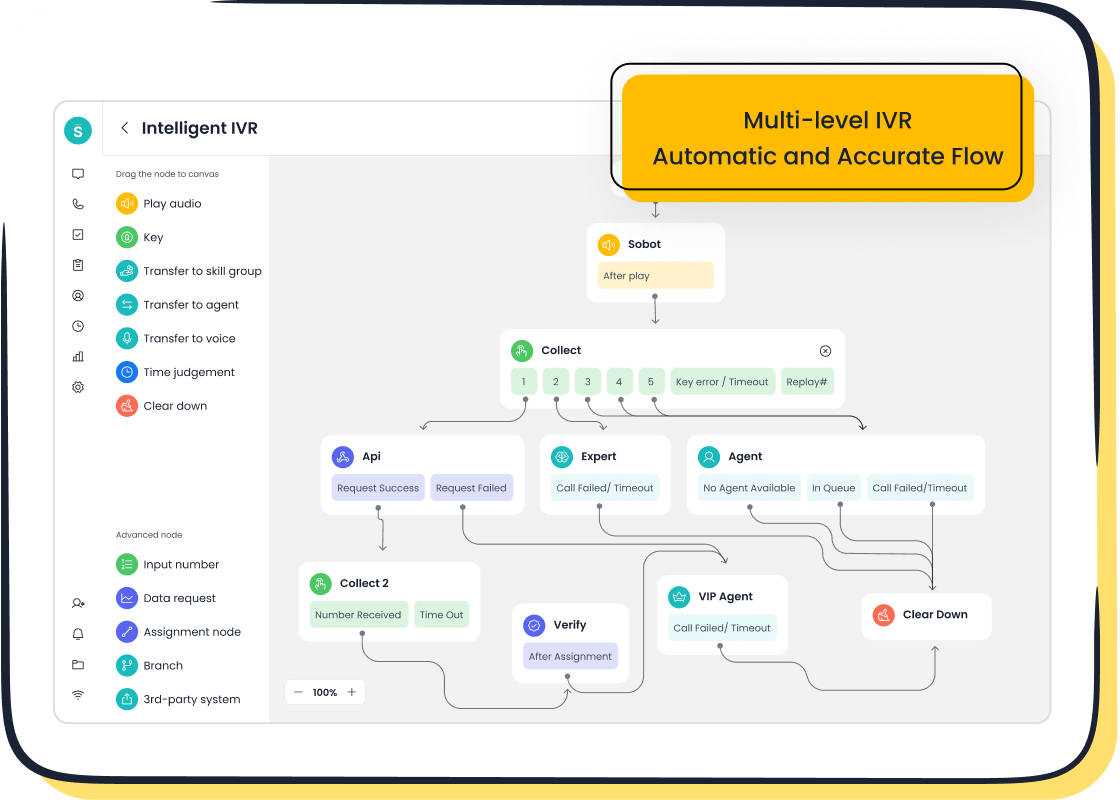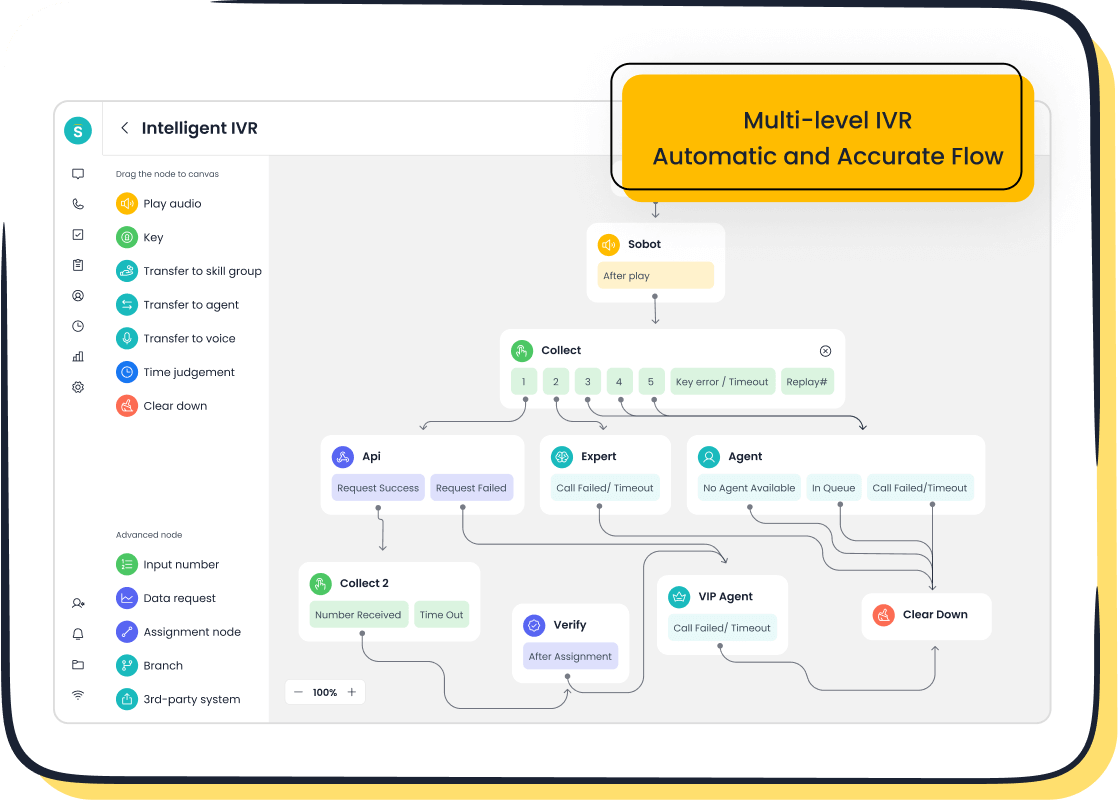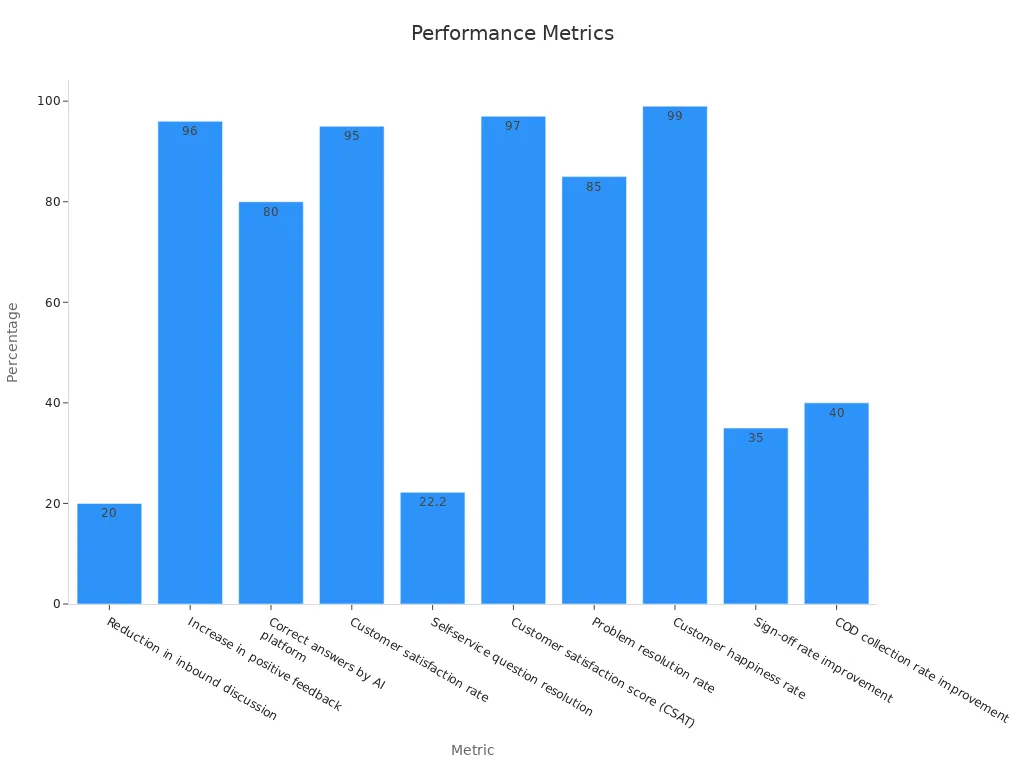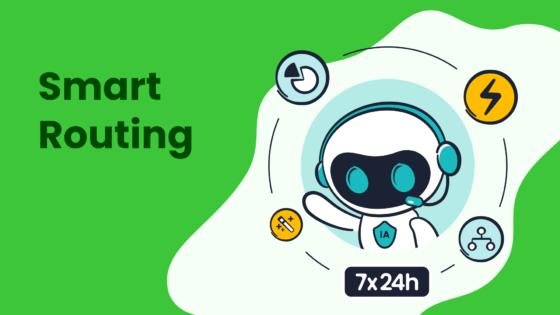Comparing Reporting Features of Contact Center Software

Efficient reporting features in contact center software play a key role in improving how businesses operate and serve customers. These tools gather data from multiple sources, offering a complete view of customer experiences and agent performance. They help you track essential metrics like key performance indicators (KPIs) and customer satisfaction trends, which are critical for maintaining service quality. Real-time alerts for dissatisfied customers allow immediate recovery actions, while analytics ensure data-driven decisions for training and scheduling. Sobot, with its advanced tools, ensures that contact center software reports empower businesses to enhance both efficiency and satisfaction.
Understanding Reporting Features in Contact Center Software
What Are Reporting Features in Contact Center Software?
Reporting features in contact center software are tools that collect, organize, and present data about your operations. These features help you track key metrics like call volume, average handle time, and customer satisfaction. They also provide insights into agent performance and customer behavior. For example, you can monitor peak hour traffic to allocate resources effectively or measure first call resolution rates to improve service quality.
Here’s a quick look at some essential metrics tracked by reporting tools:
| Metric | Description |
|---|---|
| Call volume | Total number of calls received |
| Average wait time | Average time a caller waits before being answered |
| Average handle time | Average duration of a call |
| First call resolution | Percentage of issues resolved on the first call |
| Customer satisfaction | Overall satisfaction level of customers |
These metrics give you a clear picture of your contact center's performance, helping you make informed decisions.
Why Reporting Features Are Essential for Contact Centers
Reporting features are vital for maintaining high service standards in your contact center. They allow you to monitor operations in real time, ensuring that agents meet performance goals and customers receive timely support. For instance, tracking customer satisfaction scores helps you identify areas for improvement, while monitoring agent performance ensures consistent service quality.
Advanced reporting and analytics also enhance compliance. By analyzing recorded interactions, you can ensure that your team follows industry regulations. Additionally, these tools support faster dispute resolution by providing detailed call records. This not only improves customer trust but also reduces operational risks.
Benefits of Advanced Reporting Tools in Contact Center Software
Advanced reporting tools in contact center software offer numerous benefits. They improve agent performance by providing real-time feedback and actionable insights. For example, analytics tools evaluate how well agents adhere to guidelines, helping you identify training needs. These tools also optimize costs by highlighting inefficiencies in workflows.
Another key benefit is better management of remote workforces. Reporting tools measure the productivity of remote agents, enabling you to provide targeted coaching and support. Moreover, they enhance the customer experience by building detailed profiles and monitoring interactions. This allows you to personalize the customer journey, leading to higher satisfaction and loyalty.
| Benefit | Description |
|---|---|
| Improved Agent Performance | Evaluates agents’ interactions and adherence to guidelines. |
| Cost Optimization | Identifies inefficiencies in workflows, leading to savings. |
| Enhanced Customer Experience | Builds customer profiles to optimize the customer journey. |
By leveraging these tools, you can transform your contact center into a hub of efficiency and customer satisfaction.
Key Reporting Features to Look For in Contact Center Software

Real-Time Analytics and Monitoring
Real-time analytics and monitoring are essential for maintaining high performance in your contact center. These features allow you to track live metrics such as call volume, average handle time, and customer satisfaction. By analyzing this data instantly, you can identify and resolve issues before they escalate. For example, real-time speech analytics can assess customer sentiment during live calls, helping agents adjust their approach to improve outcomes.
You can also use predictive analytics to foresee potential challenges. This capability helps you allocate resources effectively by predicting call volumes and optimizing agent schedules. AI-powered recommendations further enhance decision-making by offering personalized solutions based on customer history and current interactions. These tools ensure your contact center operates efficiently while delivering exceptional service.
| Criteria/Metric | Description |
|---|---|
| Real-time monitoring | Tracks live performance metrics for quick issue resolution. |
| Predictive analytics | Forecasts trends to optimize resource allocation and strategy adjustments. |
| Agent performance metrics | Measures KPIs like first-call resolution and client satisfaction ratings. |
Customizable Dashboards for Tailored Insights
Customizable dashboards provide you with a clear and personalized view of your contact center's performance. These dashboards allow you to track the metrics that matter most to your business. For instance, you can create role-based dashboards tailored for agents, supervisors, or managers. This ensures that each team member has access to the insights they need to excel in their roles.
Gathering input from your team is crucial when designing dashboards. This collaborative approach ensures the dashboards meet user needs, enhancing functionality and user experience. Features like automated alerts notify you of unmet performance objectives, enabling proactive management. Wallboards displaying leaderboards and other engaging content can also motivate agents to improve their performance.
| Feature | Description |
|---|---|
| Role-based Dashboards | Provides tailored information for different roles. |
| Automated Alerts | Sends notifications for unmet objectives. |
| Customizable KPIs | Allows tracking of unique metrics based on business needs. |
Historical Reporting for Long-Term Analysis
Historical reporting enables you to analyze past performance and make informed decisions for the future. By examining historical data, you can identify trends, mitigate risks, and enhance predictive analysis. For example, a retail chain might use historical customer behavior data to improve its online presence and target advertising more effectively.
This feature also supports strategic planning. You can use historical insights to set long-term goals and refine your strategies. For instance, an insurance company could analyze past claims data to identify risk trends and adjust premiums accordingly. Historical reporting provides a solid foundation for making data-driven decisions that align with your business objectives.
- Benefits of historical reporting:
- Identifies patterns and trends for better planning.
- Enhances forecasting accuracy through predictive analysis.
- Informs strategic decisions based on past performance.
Integration with Other Tools and Systems
Effective contact center software should seamlessly integrate with other tools and systems to maximize its potential. Integration ensures that your reporting and analytics capabilities are not limited to isolated data but instead draw from a unified ecosystem. This connectivity enhances the accuracy and relevance of the insights you gain.
Modern contact center software excels in connecting with various platforms. For example:
- Data Aggregation: It consolidates information from multiple sources, such as CRM systems, ticketing platforms, and social media channels, into one centralized location.
- Real-Time Data Updates: Continuous data retrieval ensures that your reports reflect the most current metrics.
- Data Transformation and Enrichment: It preprocesses and refines raw data, making it more actionable for decision-making.
Additionally, advanced systems can integrate with legacy tools, modernizing outdated infrastructures. For instance, linking a legacy CRM to a data warehouse allows you to maintain historical data while leveraging modern reporting tools. Enterprise Application Integration (EAI) further automates data exchange between subsystems, streamlining operations across your contact center.
These integrations empower you to track call center analytics more effectively. They also enable you to create comprehensive reports that provide actionable insights, helping you optimize agent performance and customer satisfaction.
Predictive Analytics and AI-Driven Insights
Predictive analytics and AI-driven insights are transforming how contact centers operate. These advanced capabilities allow you to anticipate challenges and make proactive decisions. For example, predictive models can forecast call volumes, enabling you to allocate resources efficiently. AI-driven insights analyze customer behavior, helping you personalize interactions and improve satisfaction.
The benefits of these tools are significant:
| Benefits | Description |
|---|---|
| Enhanced Decision-Making | Data-driven insights streamline managerial decisions and resource allocation. |
| Improved Customer Experience | Real-time analytics enable swift adjustments to meet customer needs. |
| Increased Operational Efficiency | Immediate performance tracking leads to optimized call handling and agent productivity. |
Research highlights the impact of these tools. A 2022 NICE report revealed that 95% of customers value personalized service for loyalty. Additionally, contact centers using real-time analytics have reduced average handle time by 40%. These statistics underscore the importance of incorporating predictive analytics into your contact center software.
By leveraging these advanced reporting and analytics tools, you can transform your contact center into a proactive, customer-focused operation. This approach not only enhances efficiency but also ensures that your business remains competitive in a rapidly evolving market.
Comparing Reporting Features of the Best Contact Center Software
NICE CXone: Comprehensive Reporting and Analytics
NICE CXone stands out as a leader in comprehensive reporting and analytics. Its reporting capabilities empower you to make data-driven decisions with ease. The platform offers customizable dashboards that allow you to drag and drop widgets, tailoring real-time and historical insights to your needs. You can access hundreds of pre-built reports and metrics, giving you a detailed view of your contact center's performance. These reports include prebuilt, standard, BI, custom, and data download options, ensuring flexibility for various business requirements.
With NICE CXone, you can track performance metrics like call volume and customer satisfaction analytics effortlessly. The platform’s advanced reporting and analytics tools help you identify trends and optimize operations. Whether you need actionable reports for immediate decisions or long-term planning, NICE CXone provides the tools to enhance your contact center's efficiency.
Five9: User-Friendly Reporting Tools
Five9 simplifies reporting with its user-friendly tools designed to enhance collaboration and efficiency. Its intuitive interface makes it easy for your team to share insights and track key metrics. The platform’s advanced analytics capabilities allow you to monitor performance metrics and optimize customer interactions effectively. Real-time insights further improve decision-making by providing up-to-date data on call center analytics.
| Feature | Description |
|---|---|
| User-Friendly Interface | Facilitates collaboration among team members, making it easier to share insights quickly. |
| Advanced Analytics | Allows businesses to track key performance indicators effectively, optimizing each interaction. |
| Real-Time Insights | Enhances decision-making and operational efficiency for call centers. |
Five9’s reporting tools ensure that you can focus on improving customer support while maintaining operational efficiency. Its ease of use makes it a great choice for businesses seeking straightforward yet powerful reporting capabilities.
Genesys Cloud CX: Advanced AI-Powered Insights
Genesys Cloud CX takes reporting to the next level with its AI-powered insights. This platform uses predictive analytics to help you anticipate challenges and allocate resources effectively. By analyzing customer interactions, it provides personalized recommendations that improve customer satisfaction. Its real-time analytics capabilities allow you to monitor live metrics, ensuring your contact center operates at peak performance.
The platform’s integration with CRM systems enhances its reporting capabilities, enabling you to create comprehensive reports that combine customer relationship management data with operational metrics. Genesys Cloud CX helps you transform raw data into actionable insights, making it easier to optimize your contact center’s performance and deliver exceptional customer experiences.
RingCentral Contact Center: Flexible Reporting Options
RingCentral Contact Center offers flexible reporting tools designed to meet the diverse needs of businesses. Its reporting features allow you to generate detailed insights into your contact center's performance. You can customize reports to focus on specific metrics, such as call volume or customer satisfaction, ensuring that you track the data most relevant to your goals. These tools also support real-time analytics, enabling you to monitor live operations and make quick adjustments when needed.
One standout feature is the platform's ability to integrate with other systems. This ensures that your reporting data is comprehensive and actionable. For example, by connecting with CRM platforms, RingCentral Contact Center consolidates customer data, providing a unified view of interactions. This integration enhances call center analytics and helps you identify trends that improve decision-making.
RingCentral's reporting tools are user-friendly, making them accessible even for teams with limited technical expertise. Automated alerts notify you of performance issues, allowing you to address them promptly. These features make RingCentral a strong choice for businesses seeking adaptable and efficient contact center software.

Sobot Voice/Call Center: Intelligent Reporting and Monitoring
Sobot Voice/Call Center stands out with its intelligent reporting and monitoring capabilities. Its advanced tools provide real-time and historical insights, helping you optimize your contact center operations. The platform tracks key metrics like customer satisfaction, problem resolution rates, and agent performance. These insights empower you to make data-driven decisions that enhance both efficiency and customer experience.
Sobot's AI-powered analytics deliver precise and actionable data. For instance, the system identifies patterns in customer interactions, enabling you to predict and address potential issues. This proactive approach improves service quality and reduces inbound discussions by 20%. Additionally, Sobot's self-service tools resolve 22.2% of customer queries, freeing up agents to focus on complex tasks.
The platform's success is evident in its results. Companies like Michael Kors have improved customer service and marketing using Sobot's solutions. The following table highlights some of the impressive outcomes achieved with Sobot Voice/Call Center:
| Metric | Result |
|---|---|
| Reduction in inbound discussion | 20% |
| Increase in positive feedback | 96% |
| Customer satisfaction rate | 95% |
| Problem resolution rate | 85% |
| Customer happiness rate | 99% |

Sobot Voice/Call Center combines robust reporting tools with seamless integration, making it an ideal choice for businesses aiming to enhance their contact center software.
Comparison Table of Reporting Features Across Top Solutions
The table below compares the reporting features of the top contact center software solutions, helping you identify the best fit for your business:
| Feature | NICE CXone | Five9 | Genesys Cloud CX | RingCentral Contact Center | Sobot Voice/Call Center |
|---|---|---|---|---|---|
| Real-Time Analytics | ✅ | ✅ | ✅ | ✅ | ✅ |
| Customizable Dashboards | ✅ | ✅ | ✅ | ✅ | ✅ |
| AI-Powered Insights | ✅ | ✅ | ✅ | ✅ | ✅ |
| Integration with Other Tools | ✅ | ✅ | ✅ | ✅ | ✅ |
| Historical Reporting | ✅ | ✅ | ✅ | ✅ | ✅ |
| Customer Satisfaction Metrics | ✅ | ✅ | ✅ | ✅ | ✅ |
This comparison highlights Sobot Voice/Call Center's comprehensive capabilities, making it a standout choice for businesses seeking intelligent reporting and monitoring.
How to Choose the Best Contact Center Software for Reporting Needs
Identifying Your Business Requirements
Understanding your business needs is the first step in selecting the right contact center software. Start by analyzing your current operations and identifying gaps in performance. For example, if you struggle with fragmented data, prioritize software with robust CRM integration. Use analytics tools to gather insights into your call center analytics, such as agent performance and customer satisfaction analytics. These insights will help you pinpoint areas for improvement.
You can also conduct customer surveys to understand their expectations. Real-time monitoring and speech analytics provide additional clarity by tracking customer interactions and agent behavior. Aligning these findings with your business goals ensures the software you choose meets your unique requirements.
| Method/Approach | Description |
|---|---|
| Analytics Tools | Gather and interpret data for operational insights. |
| Integration with CRM | Ensure seamless data collection and connectivity. |
| Real-time Monitoring | Track performance and interactions as they happen. |
| Speech Analytics | Assess agent performance and identify training needs. |
| Customer Surveys | Collect qualitative feedback to inform reporting requirements. |
Evaluating Scalability and Flexibility
Scalability and flexibility are crucial for long-term success. Your contact center software should adapt to growing demands without compromising performance. Define key performance indicators (KPIs) and establish benchmarks to measure scalability. For instance, evaluate response times, CPU usage, and memory consumption under varying workloads.
Performance monitoring tools help assess system health in real time. Metrics like processing times and error rates highlight potential issues during peak usage. Additionally, ensure the software supports integration with new modules or updates. This flexibility allows you to expand capabilities as your business evolves.
| Metric | Description |
|---|---|
| Processing Times | Measures the time taken to process requests, indicating system efficiency. |
| Error Rates | Tracks the frequency of errors, highlighting potential issues under load. |
| Integration Ability | Assesses how well the system can incorporate new modules or updates. |
Considering Ease of Use and Training
Ease of use directly impacts how quickly your team can adopt new software. Choose contact center software with an intuitive interface that simplifies navigation. Customizable dashboards tailored to different roles, such as agents and managers, enhance usability. Automated alerts and visual tools like leaderboards further improve user engagement.
Training is equally important. Opt for software that offers comprehensive training resources, including tutorials and live support. This ensures your team can maximize the software’s potential. A user-friendly platform combined with effective training boosts productivity and improves customer support outcomes.
Tip: Involve your team in the evaluation process. Their feedback ensures the software aligns with daily operational needs.
Importance of Integration and Compatibility
Integration and compatibility are essential for maximizing the potential of your contact center software. Seamless integration connects your reporting tools with other enterprise systems, such as CRM platforms or ERP solutions. This connectivity eliminates data silos, ensuring a unified flow of information across your organization. For example, integrating with over 150 GL/ERP systems, including SAP and Oracle, enhances Corporate Performance Management (CPM) processes. This allows your team to access accurate, real-time data for better decision-making.
A well-integrated system also improves productivity. By reducing manual data entry and errors, your team can focus on delivering exceptional customer service. Collaboration becomes easier when tools and systems work together, fostering teamwork and streamlining operations. For instance, linking call center analytics with CRM systems provides a comprehensive view of customer interactions, enabling you to personalize service and improve satisfaction.
The benefits of integration extend to decision-making as well. Unified data from multiple sources allows you to analyze metrics more effectively, leading to actionable insights. A table below highlights the key advantages of seamless integration:
| Benefit | Description |
|---|---|
| Streamlined Operations | Integration eliminates silos, allowing for a unified flow of information. |
| Enhanced Productivity | Reduces errors and improves efficiency in processes. |
| Better Collaboration | Fosters teamwork by connecting various tools and systems. |
| Improved Decision-Making | Provides unified data for more informed decisions. |
By prioritizing integration and compatibility, you ensure that your contact center operates efficiently while delivering a superior customer experience.
Budget and ROI Considerations
Investing in contact center software with robust reporting capabilities can significantly impact your budget and ROI. Automated reporting reduces manual effort, saving time and resources. This feature ensures consistent report generation, enhancing data accuracy and enabling your team to focus on strategic tasks. Customizable dashboards further optimize operations by allowing you to track key metrics in real-time, ensuring you monitor what matters most to your business.
In-depth analytics provide deeper insights into customer interactions and agent performance. These insights help you identify inefficiencies and implement targeted improvements, ultimately reducing costs. For example, understanding call center analytics can reveal patterns in customer behavior, enabling you to allocate resources more effectively. This proactive approach minimizes wasted effort and maximizes returns.
When evaluating software, consider the long-term financial benefits. While initial costs may seem high, the efficiency gains and improved customer satisfaction often outweigh the investment. Businesses that adopt advanced reporting tools frequently experience higher ROI due to better decision-making and streamlined operations. By choosing software that aligns with your goals, you ensure sustainable growth and cost-effectiveness.
Tip: Focus on software that offers both scalability and flexibility. These features allow your contact center to adapt to changing demands, ensuring you get the most value from your investment.
Real-World Applications of Contact Center Software Reports

Enhancing Agent Performance with Data Insights
Contact center software reports provide actionable insights that help you improve agent performance. By analyzing metrics like customer satisfaction scores, first call resolution rates, and average handle time, you can identify areas where agents need support. For example, empowering agents with decision-making authority and offering targeted training enhances their ability to resolve issues on the first call. Monitoring call durations ensures agents balance efficiency with service quality, avoiding rushed interactions.
These insights also enable personalized coaching. When you track response times and resolution rates, you can provide feedback tailored to each agent’s strengths and weaknesses. This approach boosts productivity and ensures consistent service quality. A table below highlights key metrics and their impact on agent performance:
| Metric | Description | Improvement Insights |
|---|---|---|
| Customer Satisfaction Score | Measures customer satisfaction with service experience. | Act on feedback to improve scores, utilize AI for routine inquiries, and communicate changes to boost productivity. |
| First Call Resolution | Indicates the percentage of issues resolved on the first call. | Empower agents with decision-making authority and provide comprehensive training to enhance first contact resolution rates. |
| Average Handle Time | Measures the time taken to resolve customer inquiries. | Monitor call durations to balance efficiency and service quality, ensuring agents are not rushed while maintaining industry standards. |
Improving Customer Experience Through Analytics
Analytics derived from contact center software reports transform how you deliver customer support. By tracking metrics such as Net Promoter Score (NPS), Customer Satisfaction Score (CSAT), and Customer Effort Score (CES), you gain a deeper understanding of customer needs. These insights allow you to personalize interactions, ensuring customers feel valued and heard.
For instance, customer satisfaction analytics highlight areas where your service can improve. If average handle time is high, you can implement strategies to streamline processes. Similarly, first call resolution rates reveal how effectively agents address issues. By addressing these metrics, you enhance customer loyalty and satisfaction. A table below outlines key metrics that drive customer experience improvements:
| Metric Type | Description |
|---|---|
| Call Center Performance Metrics | Metrics like Average Handle Time (AHT), First Call Resolution (FCR), and Service Level provide insights into agent performance and customer satisfaction. |
| Agent Performance Metrics | Insights into response times and resolution rates enable targeted training and personalized feedback for agents. |
| Customer Experience Metrics | Metrics such as Customer Satisfaction Score (CSAT), Net Promoter Score (NPS), and Customer Effort Score (CES) help businesses understand and address customer needs. |
Optimizing Operational Efficiency with Reporting Tools
Contact center software reports play a crucial role in optimizing operational efficiency. By analyzing metrics like service level, average speed of answer (ASA), and call abandonment rate, you can identify bottlenecks and implement solutions. For example, tracking ASA data helps you reduce response times, improving customer satisfaction. Similarly, monitoring call abandonment rates ensures you address issues that lead to dropped calls.
Reporting tools also streamline after-call work (ACW). By managing ACW effectively, agents can focus more on customer interactions, boosting overall productivity. Companies like Lotte.com and Cementos Argos have leveraged reporting tools to achieve remarkable results. The table below showcases real-world applications:
| Company | Challenge | Solution | Results |
|---|---|---|---|
| Lotte.com | Understanding shopping cart abandonment | Implemented customer experience analytics to analyze behavior | Increased customer loyalty and $10 million in sales after addressing checkout issues. |
| Cementos Argos | Seeking competitive advantage and better decisions | Created a business analytics center and invested in data science teams | Standardized finance processes and improved profitability through better customer insights. |
| Baylis & Harding | Need for better visibility into business data | Used BI tools for standard and ad hoc reporting | Executives gained instant access to data, enabling proactive decision-making. |
| Sabre Airline Solutions | Need for real-time customer behavior insights | Developed an enterprise travel data warehouse for data aggregation | Enhanced revenue and client satisfaction through improved operational insights. |
| Spear Education | Streamlining internal processes | Implemented BI to improve workflow and data access | Increased efficiency in internal processes and decision-making. |
By leveraging reporting tools, you can make data-driven decisions that improve efficiency and customer satisfaction.
Identifying Trends and Making Data-Driven Decisions
Identifying trends in your contact center is essential for staying ahead in a competitive market. Reporting tools transform raw data into actionable insights, helping you uncover patterns that drive better decisions. By analyzing these trends, you can improve customer satisfaction, optimize operations, and enhance agent performance.
To identify trends effectively, you need to rely on advanced analytics tools. These tools provide a combination of real-time analytics, historical data reviews, and sentiment analysis. Real-time analytics allow you to monitor live interactions, revealing immediate issues that need attention. Historical data reviews help you spot recurring patterns, such as peak call times or common customer complaints. Sentiment analysis evaluates customer emotions during interactions, giving you a deeper understanding of their experiences.
Here are some ways trend analysis reports and data visualizations can help you:
- Call Center Analytics: These tools convert raw data into insights, enabling you to track customer satisfaction and operational efficiency.
- Agent Performance Assessment: Advanced analytics highlight areas where agents excel or need improvement, guiding targeted training efforts.
- Operational Efficiency: By identifying bottlenecks, you can streamline workflows and allocate resources more effectively.
For example, if you notice a trend of increased call volume during specific hours, you can adjust staffing levels to reduce wait times. Similarly, sentiment analysis might reveal that customers frequently express frustration about a particular issue. Addressing this proactively can improve satisfaction and loyalty.
By leveraging these insights, you can make informed decisions that align with your business goals. Trend analysis not only enhances your contact center’s efficiency but also ensures a superior customer experience.
Robust reporting features are essential for improving your contact center's efficiency and customer satisfaction. They help you track performance, identify trends, and make data-driven decisions. Each software solution offers unique strengths. For example, NICE CXone excels in customizable dashboards, while Genesys Cloud CX leads in AI-powered insights. However, Sobot Voice/Call Center stands out with its intelligent reporting, seamless integration, and proven results like a 95% customer satisfaction rate.
Tip: Focus on your business goals and reporting needs. Choose software that aligns with your operational priorities, offers scalability, and delivers measurable ROI.
FAQ
What are the key metrics to track in contact center reporting?
You should focus on metrics like call volume, average handle time, first call resolution, and customer satisfaction. These metrics provide insights into agent performance and customer experience, helping you identify areas for improvement and optimize operations.
How does real-time reporting improve contact center performance?
Real-time reporting allows you to monitor live metrics like call volume and customer sentiment. This helps you address issues immediately, allocate resources effectively, and ensure smooth operations. It also enhances decision-making by providing up-to-date data.
Can reporting tools integrate with existing systems?
Yes, most advanced reporting tools integrate seamlessly with CRM, ERP, and other systems. This ensures unified data flow, eliminates silos, and provides comprehensive insights. Integration enhances productivity and allows you to make informed decisions based on consolidated information.
Why is historical reporting important for contact centers?
Historical reporting helps you analyze past performance to identify trends and patterns. It supports long-term planning, risk mitigation, and strategy refinement. By understanding historical data, you can make data-driven decisions that align with your business goals.
How do AI-driven insights benefit contact center reporting?
AI-driven insights analyze customer behavior and predict trends. They help you personalize interactions, allocate resources efficiently, and improve customer satisfaction. These tools also provide actionable recommendations, enabling you to enhance both operational efficiency and service quality.
See Also
Essential Aspects of CRM Call Center Solutions Explored
Comprehensive Overview of Omnichannel Call Center Solutions
Essential Guide for Quality Assurance in Call Centers